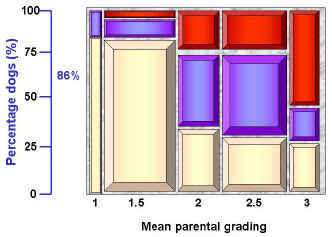Cavalier King Charles Spaniels
Est. 1976
Mitral Valve Disease
|
MITRAL VALVE DISEASE is the most serious problem facing the
Cavalier King Charles Spaniel today. Nearly 100% of all
Cavaliers will develop MVD by age 10. MVD is a
developmental fault involving the mitral valve of the heart. With each beat of the heart the four different valves open to
let blood through at the right time and then close so that blood
cannot flow backward. When a dog develops MVD, the
collagen/connective tissue that makes up the mitral valve starts
to break down and starts causing the mitral valve to not be able
to close all the way. Blood leaks backwards and this
*leakage* causes a sound that is called a murmur. Over
time the mitral valve gets sloppier and more and more blood
leaks backwards causing the murmur to get louder. The more
blood that leaks backwards the harder the heart has to work to
keep the blood moving so the body can get enough oxygen. The valve can get so sloppy that eventually the dog will go into
congestive heart failure. At this point in time,
medication is necessary to prolong the dog's life.
Sweden did a study in 1993, showing that MVD is a multi-factoral
polygenic trait. This means that genetic factors AND
environmental factors (i.e. diet, environmental
toxins/vaccinations, fitness of body--underweight or overweight)
can contribute to how severely MVD will be expressed. The
genetic component is QUITE strong. Puppies WILL, on
average, tend to follow in their parent's footsteps as to when
they will develop MVD, in fact this incidence is somewhere in
the 86-88% range in just the first generation. This means
that if both mom and dad are clear of MVD past age 5, about
86-88% of their offspring will still be clear of MVD at
approximately age 5 as well. And this ALSO means that if
both parents develop mitral valve disease BEFORE age 5, close to
86-88% of their offspring will ALSO develop MVD BEFORE age 5. BUT, approximately 10-15% of their offspring will not follow in
their parents footsteps and may develop MVD earlier or later.
Below is a graph showing the results of this study. The
chart on the left explains what intensity murmur each color
represents. No murmur is what is hoped for. The
higher the grade, the worse the murmur. The chart on the
right shows the comparison of the mean parental grading. *Mean parental grading* is the average of the murmurs of the two
parents. If both parents were grade 1, then the mean
parental quality would be 1 + 1 divided by 2 = 1. If one
parent was a grade 1 and the other a grade 2 then 1 + 2 divided
by 2 = 1.5. The graph clearly shows the parents that were
most affected (had a higher grade MVD murmur) produced more
affected offspring (by age 5) than did the parents less
affected.
HEART PROTOCOL
(1) Individual Cavaliers that have attained the age of 5 and are
SUBSEQUENTLY (AFTER age 5) found to still be clear of MVD
(regardless of parental status);
OR
(2) Cavaliers that have attained the age of 2.5 years and are
subsequently found to still be clear of MVD, AND whose parents
BOTH attained the age of 5 years and were subsequently found to
be still clear of MVD;
AND
in a way that puts emphasis on long-lived, delayed onset
ancestors.
The cut-off age of 5 was chosen for two reasons: (1)
Dogs that attain the age of 5 still free of MVD are already in
the upper 50th percentile--or are in the *better half*, the half
which we WANT to use in our breeding programs. (2) Since
the gene pool for the Cavalier is small, eliminating only the
*worst* half of the population will still allow us to maintain a
decent-sized gene pool and progress slowly towards a later and
later onset of MVD.
Although the protocol is voluntary, it is hoped that as time
goes by, more and more breeders will be able to follow this
protocol.
BEFORE you buy a puppy from ANY breeder, please ask for copies
of the current cardiologist heart clearances of BOTH parents. Because MVD is a developmental fault, it simply cannot be
checked for in a puppy. It is the parents that need the
clearance form. Look any forms you receive over well. Virtually all of them, even if they vary from the examples
shown, will state the name of the dog that was examined, the
date of examination somewhere on the form and clearly state the
name of the Board CERTIFIED veterinary cardiologist. Please
look for these specifics. A vet signed statement is
NOT acceptable. The vast majority of veterinarians CANNOT
hear low grade murmurs (grades 1 and 2), so ONLY Board Certified
Cardiologist clearances are acceptable.
For more on MVD, please go to this site: www.ckcsc.org. This is the Cavalier King Charles Spaniel Club, USA, Inc., site. Click on Health and then MVD to read more. You can also
view and/or download the Transcript from the Atlanta Heart
Symposium in 1998, which presented the Swedish study and
proposed the heart protocol, at the CKCSC site also.
Last is a copy of the *official* OFA cardiac clearance form
which a breeder receives after sending in the Application form. When looking at this form, be sure to note whether or not there
is a letter "C" right after the last slash in the OFA
Registration Number. The letter *C* indicates that the
heart auscultation was done by a board certified cardiologist. If there is no *C*--the certificate is not acceptable.
|
Copyright 2023 Roycroft Cavaliers
No part of this site may be copied or reproduced without written permission.





